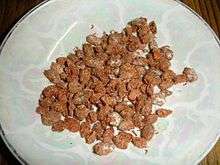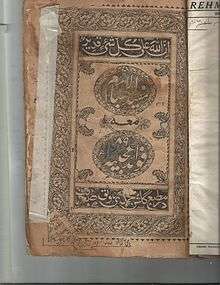Unani medicine
| This article is part of a series on |
| Fringe medicine and medical conspiracy theories |
|---|
 |
|
General information |
|

"Unani" or "Yunani medicine" (Urdu: طب یونانی tibb yūnānī[1]) is the term for Perso-Arabic traditional medicine as practiced in Mughal India and in Muslim culture in South Asia and modern day Central Asia The term Yūnānī means "Greek",[2][3] as the Perso-Arabic system of medicine was based on the teachings of the Greek physicians Hippocrates and Galen.[4]
The Hellenistic origin of Unani medicine is still visible in its being based on the classical four humours: phlegm (balgham), blood (dam), yellow bile (ṣafrā) and black bile (saudā'), but it has also been influenced by Indian and Chinese traditional systems.[5]
History
Arab and Persian elaborations upon the Greek system of medicine by figures like Ibn Sina and al-Razi influenced the early development of Unani.[6][7]
The medical tradition of medieval Islam was introduced to India by the 13th century with the establishment of the Delhi Sultanate and it took its own course of development during the Mughal Empire,[8][9] influenced by Indian medical teachings of Sushruta and Charaka.[10][11] Alauddin Khalji (d. 1316) had several eminent physicians (Hakims) at his royal courts.[12] This royal patronage led to the development of Unani in India, and also the creation of Unani literature with the aid of Indian Ayurvedic physicians.[13][14]
Diagnosis and treatment

According to Unani medicine, management of any disease depends upon the diagnosis of disease. Proper diagnosis depends upon observation of the patient's symptoms and temperament.
Unani, like Ayurveda, is based on theory of the presence of the elements in the human body. According to followers of Unani medicine, these elements are present in fluids and their balance leads to health and their imbalance leads to illness.
According to Unani practitioners, the failure of the Quwwat-e-Mudabbira-e-Badan, or the body's ability to maintain its own healty, may lead to derangement of the normal equilibrium of the body's akhlat (humors). Abnormal humors are believed to lead to pathological changes in the tissues at the affected site, creating the clinical manifestations of illness. The theory postulates the presence of blood, phlegm, yellow bile and black bile in the human body. Each person's unique mixture of these substances determines his mizaj (temperament). A predominance of blood gives a sanguine temperament; a predominance of phlegm makes one phlegmatic; yellow bile, bilious (or choleric); and black bile, melancholic.
After diagnosing the disease, treatment follows a pattern:
- Izalae Sabab (elimination of cause)
- Tadeele Akhlat (normalization of humors)
- Tadeele Aza (normalization of tissues/organs)
Treatment includes regimental therapy known as Ilaj-Bil-Tadbeer. These therapies include cupping, aromatherapy, bloodletting, bathing, exercise, and dalak (massaging the body). It may also involve the prescription of Unani drugs or surgery.[15][16]
Unani products like egg oil and almond oil are commonly used for hair care in India, and registered Unani practitioners are treated as qualified doctors in India and Pakistan.
Education and recognition
There are several Indian universities devoted to Unani medicine, in addition to universities that teach traditional Indian medical practices in general.[17] Undergraduate degrees awarded for completing an Unani program include the Bachelor of Unani Medicine and Surgery, Bachelor of Unani Tib and Surgery, and Bachelor of Unani Medicine with Modern Medicine and Surgery degrees. A small number of universities offer post-graduate degrees in Unani medicine.[18]
The Central Council of Indian Medicine (CCIM), a statutory body established in 1971 under the Department of Ayurveda, Yoga and Naturopathy, Unani, Siddha and Homoeopathy (AYUSH), monitors higher education in areas of Indian medicine including Ayurveda, Unani, and other traditional medical systems.[19] Another subdivision of AYUSH, the Central Council for Research in Unani Medicine (CCRUM),[20] aids and co-ordinates scientific research in the Unani system of medicine through a network of 22 nationwide research institutes and units.[21]
To fight biopiracy and unethical patents, the Government of India set up the Traditional Knowledge Digital Library in 2001 as repository of formulations used in Indian traditional medicine, including 98,700 Unani formulations.[22][23]
The government of Pakistan's National Council for Tibb is responsible for developing the curriculum of Unani courses and registering practitioners of the medicine.[24] Various private foundations devote themselves to the research and production of Unani medicines, including the Hamdard Foundation, which also runs an Unani research institution.[25] The Qarshi Foundation runs a similar institution, Qarshi University.[26] The programs are accredited by Higher Education Commission,[27] Pakistan Medical and Dental Council,[28] and the Pakistan Pharmacy Council.[29]
South Africa's University of the Western Cape bachelor's degree in Unani medicine.
Safety issues
Some medicines traditionally used by Unani practitioners are known to be poisonous.[30]
The Indian Journal of Pharmacology notes:
According to WHO, "Pharmacovigilance activities are done to monitor detection, assessment, understanding and prevention of any obnoxious adverse reactions to drugs at therapeutic concentration that is used or is intended to be used to modify or explore physiological system or pathological states for the benefit of recipient." These drugs may be any substance or product including herbs, minerals, etc. for animals and human beings and can even be that prescribed by practitioners of Unani or Ayurvedic system of medicine. In recent days, awareness has been created related to safety and adverse drug reaction monitoring of herbal drugs including Unani drugs.[31]
See also
- Iranian traditional medicine
- Ayurveda
- Dawakhana Shifaul Amraz
- Hakim Abdul Aziz
- Hakim Ajmal Khan
- Hakim Habibur Rahman
- Hakim Mohammed Said
- Hakim Syed Atiqul Qadir
- Hakim Syed Karam Husain
- Hakim Syed Zillur Rahman
- Hamdard (Wakf) Laboratories
- Hamdard Laboratories (Waqf)
- Traditional Knowledge Digital Library
- Ibn Sina Academy of Medieval Medicine and Sciences
References
- ↑ the transcription as Unani is found in 19th-century English language sources: "the Ayurvedic and Unani systems of medicine" "Madhya Pradesh District Gazetteers: Hoshangabad", Gazetteer of India 17 (1827), p. 587.
- ↑ William Dalrymple (1994). City of Djinns: A Year in Delhi. Flamingo. p. 269. ISBN 978-0-00-637595-1.
- ↑ "Unani Tibb". Science Museum, London. Retrieved 7 October 2017.
- ↑ Unani Medicine in India: Its Origin and Fundamental Concepts by Hakim Syed Zillur Rahman, History of Science, Philosophy and Culture in Indian Civilization, Vol. IV Part 2 (Medicine and Life Sciences in India), Ed. B. V. Subbarayappa, Centre for Studies in Civilizations, Project of History of Indian Science, Philosophy and Culture, New Delhi, 2001, pp. 298-325
- ↑ Heyadri, Mojtaba; Hashempur, Mohammad Hashem; Ayati, Mohammad Hosein; Quintern, Detlev; Nimrouzi, Majid; Mosavat, Seyed Hamdollah (2015). "The use of Chinese herbal drugs in Islamic medicine". Journal of Integrative Medicine. 13 (6): 363. doi:10.1016/S2095-4964(15)60205-9. PMID 26559361.
- ↑ Unani Medicine in India during 1901–1947 by Hakim Syed Zillur Rahman, Studies in History of Medicine and Science, IHMMR, New Delhi, Vol. XIII, No. 1, 1994, p. 97-112.
- ↑ Alam, Zulfeequar (2008). Herbal Medicines. APH. p. 13-15. ISBN 9788131303580.
- ↑ Chishti, p. 2.
- ↑ Kapoor, p. 7264
- ↑ Exchanges between India and Central Asia in the field of Medicine by Hakeem Abdul Hameed
- ↑ Interaction with China and Central Asia in the Field of Unani Medicine by Hakim Syed Zillur Rahman, History of Science, Philosophy and Culture in Indian Civilization, Vol. III Part 2 (India’s Interaction with China, Central and West Asia), Ed. A. Rahman, Centre for Studies in Civilizations, Project of History of Indian Science, Philosophy and Culture, New Delhi, 2002, pp. 297-314
- ↑ Indian Hakims: Their Role in the medical care of India by Hakim Syed Zillur Rahman, History of Science, Philosophy and Culture in Indian Civilization, Vol. IV Part 2 (Medicine and Life Sciences in India), Ed. B. V. Subbarayappa, Centre for Studies in Civilizations, Project of History of Indian Science, Philosophy and Culture, New Delhi, 2001, pp. 371-426
- ↑ "Unani". Department of Ayurveda, Yoga and Naturopathy, Unani, Siddha and Homoeopathy, Govt. of India. Archived from the original on 2007-12-23.
- ↑ Bala, p. 45
- ↑ Hakim Syed Zillur Rahman (1980), Kitāb al-murakkābāt, ʻAlīgaṛh: Pablikeshan Ḍivīzhan, Muslim Yūnivarsiṭī
- ↑ Mehra, Raakhee (2003). Significance of Ayurvediya Marma: Vital Body Points. p. 15-25. ISBN 978-8189973803.
- ↑ S. C. Bhatt, Gopal K. Bhargava, ed. (2006). Land and People of Indian States and Union Territories. 16. Gyan Publishing House. p. 191.
- ↑ Kumar, Ashish (2006). Handbook of Universities, Volume 1. Atlantic Publishers & Dist. p. xiii,13.
- ↑ CCIM Archived 2011-02-26 at the Wayback Machine.
- ↑ "Central Council for Research in Unani Medicine (CCRUM)". Traditional Knowledge Digital Library.
- ↑ "Research and Development: Central Council for Research in Unani Medicine (CCRUM)". Centre for Research in Indian Systems of Medicine, (CRISM).
- ↑ Traditional Knowledge Digital Library website.
- ↑ "Know Instances of Patenting on the UES of Medicinal Plants in India". PIB, Ministry of Environment and Forests. May 6, 2010.
- ↑ Bodeker, Gerard (2005). WHO Global Atlas of Traditional, Complementary and Alternative Medicine. WHO. p. 167.
- ↑ "Hamdard Research Institute of Unani Medicine, Hamdard University". Archived from the original on 15 January 2015. Retrieved 11 January 2015.
- ↑ "Department of Eastern Medicine and Surgery, Qarshi University". Retrieved 11 January 2015.
- ↑ "H.E.C. Accreditation List". Archived from the original on 2013-10-29.
- ↑ "PM&DC Accreditation List". Archived from the original on 2012-01-16. Retrieved 2012-08-03.
- ↑ "PCP Accreditation List". Pharmacy Council of Pakistan. Retrieved 2013-02-19.
- ↑ Arnold, David (2012). David Hardiman, Projit Bihari Mukharji, ed. Medical Marginality in South Asia: Situating Subaltern Therapeutics. Routledge. p. 171. ISBN 9780415502412.
- ↑ Rahman, SZ; Latif, A; Khan, RA (Dec 2008). "Importance of pharmacovigilance in Unani system of medicine". Indian J. Pharmacol. 40 (7): 17–20.
Further reading
- Standardisation of single drugs of Unani medicine. Central Council for Research in Unani Medicine (India), Ministry of Health and Family Welfare, Govt. of India, 1987.
- Unani: the science of Graeco-Arabic medicine, by Jamil Ahmad, Hakim Ashhar Qadeer. Lustre Press, 1998. ISBN 81-7436-052-2.
- The Unani Pharmacopoeia of India, Dept. of Indian Systems of Medicine & Homoeopathy. Pub. Govt. of India, Ministry of Health & Family Welfare, Dept. of Indian Systems of Medicine & Homoeopathy, 1999.
- Physicochemical standards of Unani formulations, Pub. Central Council for Research in Unani Medicine, Ministry of Health & Family Welfare, Govt. of India, 2006.
- Hakim Syed Zillur Rahman (1986), Qānūn-i ibn-i Sīnā aur us ke shārḥīn va mutarajimīn, ʻAlīgaṛh: Pablīkeshan Dīvīzan, Muslim Yūnīvarsiṭī
- Refiguring unani tibb: plural healing in late colonial India, by Guy N. A. Attewell. Orient Longman, 2007. ISBN 81-250-3017-4.
- Hand book on unani medicines with formulae, processes, uses and analysis. National Institute Of Industrial Research, 2008. ISBN 81-7833-042-3.
- Chishti, Hakim (1990). The traditional healer's handbook: a classic guide to the medicine of Avicenna. Inner Traditions / Bear & Company. ISBN 0-89281-438-1.
- Kapoor, Subodh (2002). The Indian encyclopaedia. Archery-Banog, Volume 2. Genesis Publishing. ISBN 81-7755-257-0.
- Bala, Poonam (2007). Medicine and medical policies in India: social and historical perspectives. Lexington Books. ISBN 0-7391-1322-4.
- 10 Unani medicine books online at Traditional Knowledge Digital Library (Govt. of India)
- Hakim Syed Zillur Rahman (1995), Dillī aur t̤ibb-i Yūnānī (Dillī aur t̤ibb-i Yūnānī ed.), Naʾī Dihlī: Urdū Akādmī, Dihlī
- Hakim Syed Zillur Rahman (1962), Daur-e Jadeed aur Tib, Bhopal, India: Tibbi Academy, India
- Hakim Syed Zillur Rahman (1983), Ṣafvī ʻahd men̲ ʻilm-i tashrīḥ kā mut̤ālaʻah, ʻAlīgaṛh: T̤ibbī Akādmī
